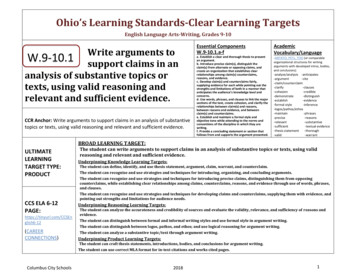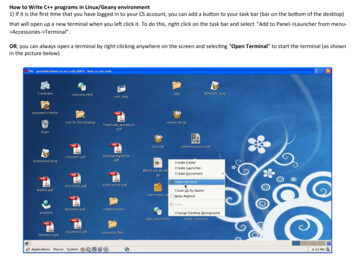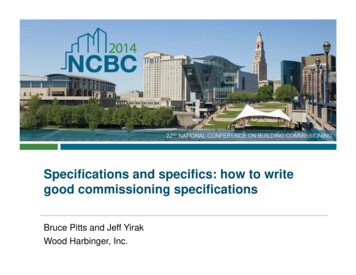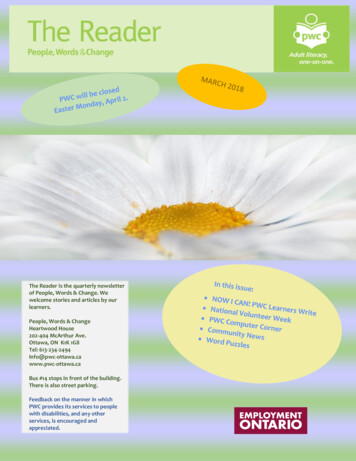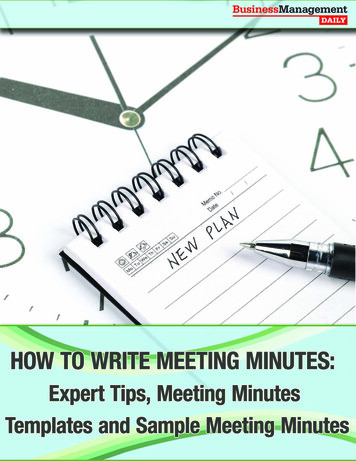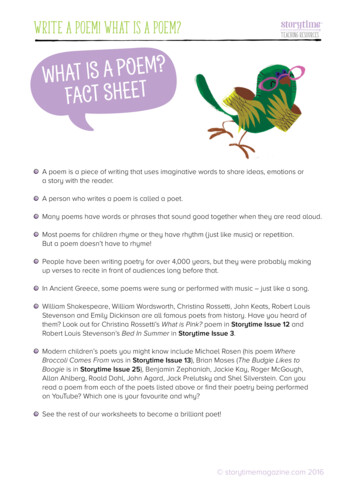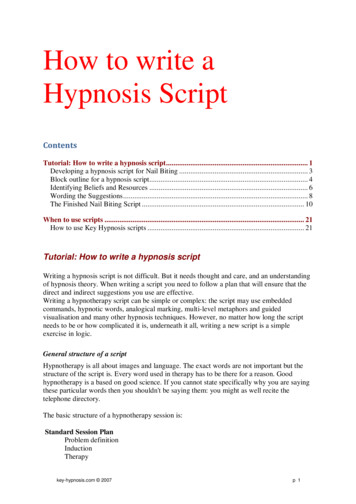
Transcription
Research MemorandumETS RM–12-05How to Write an Effective Research ReportSamuel A. LivingstonMarch 2012
How to Write an Effective Research ReportSamuel A. LivingstonETS, Princeton, New JerseyMarch 2012
As part of its nonprofit mission, ETS conducts and disseminates the results of research to advancequality and equity in education and assessment for the benefit of ETS’s constituents and the field.To obtain a PDF or a print copy of a report, please nical Review Editor: James CarlsonTechnical Reviewers: Brent Bridgeman and Michael ZiekyCopyright 2012 by Educational Testing Service. All rights reserved.ETS, the ETS logo, and LISTENING. LEARNING.LEADING. are registered trademarks of Educational TestingService (ETS).
AbstractThis guide for writers of research reports consists of practical suggestions for writing a reportthat is clear, concise, readable, and understandable. It includes suggestions for terminology andnotation and for writing each section of the report—introduction, method, results, anddiscussion. Much of the guide consists of suggestions for presenting statistical information. Anappendix compares several common types of graphs.Key words: writing, technical writing, research reports, graphsi
AcknowledgmentI thank Ruth Greenwood for her helpful suggestions on an earlier draft of this guide.ii
Table of ContentsPagePurpose of This Guide . 1Characteristics of an Effective Research Report . 1Working Ahead . 1Terminology, Notation, and Writing Style . 2Terminology . 2Abbreviations . 3Mathematical Notation. 4Writing Style . 5Writing Each Section of the Report . 5Writing the Introduction . 5Writing the Method Section . 7Writing the Results Section . 8Tables . 10Graphs . 12Writing the Discussion Section . 14The Abstract . 15Writing for Journals . 16References . 18Appendix - Types of Graphs . 19Index . 27iii
Purpose of This GuideThis guide is intended to help researchers write more effective and more readable reports ofempirical research studies. It will be helpful to people who are generally good writers but havelittle or no experience at writing this type of research report. It may also be helpful to people whoare experienced at writing this type of research report but whose reports are not as readable andeffective as they might be.This guide is not intended to be a complete course in writing—not even a complete coursein writing research reports. It focuses on the problems that arise in the writing of a particular type ofresearch report. Many people who write reports of empirical research studies also write theoreticalpapers, methodological papers, position papers, book reviews, or other types of articles. Some ofthe advice in this guide may apply to those other types of writing, but much of it will not.This guide is intended to be a compendium of helpful advice, not a list of requirements. Theadvice it contains is the product of many years of experience in writing research reports andattempting to help others write them. Nevertheless, it represents the opinions of one person. It doesnot necessarily represent the position of ETS.Characteristics of an Effective Research ReportAn effective research report has—at least—the following four characteristics: Focus: an effective report emphasizes the important information. Accuracy: an effective report does not mislead the reader. Clarity: an effective report does not confuse the reader. Conciseness: an effective report does not waste the reader’s time.Working AheadYou can begin writing the report of your study before you have actually done thestudy. Working ahead on your report allows you to use your time more efficiently, but there isan even better reason for doing it. Working ahead on the report helps you plan and conduct thestudy, because it forces you to think systematically about what you want the study to accomplish.You can begin writing the introductory section of the report as soon as you havedecided on the general approach your study will follow. You don’t have to wait until you havedetermined all the details of the method.1
You can write the method section of the report before you have analyzed the data. Youcan even begin describing your method before you have collected the data, although you may haveto make some changes if the procedure does not go exactly as planned.You can begin writing the results section of the report before you finish analyzing thedata. You can begin writing it before you finish collecting the data, or even before you startcollecting the data! Of course, you won’t have any results to report, but you can use made-up datato create examples of the tables and figures that will communicate your results. The decisions youmake in creating these tables and figures will help you decide how to analyze your data.Terminology, Notation, and Writing StyleTerminologyKnow your audience and what terms they understand. Many research reports includetechnical terms. Before you start writing the report, decide who your intended readers are. If youdon’t know whether those readers will be familiar with the technical terms you intend to use, makean effort to find out. If you are going to use any technical terms that will be unfamiliar to manyreaders, provide an explanation of those terms—but don’t include detailed explanations of technicalterms that the people reading the report will already know and understand correctly.Label each variable in your report with a term that describes only what it actuallymeasures. Avoid labels that have excess meaning —labels that imply more information than themeasurement of the variable actually provides. If the measurement is a score on a vocabulary test,call it word meanings; don’t call it verbal ability. If the measurement is a score on a task ofclassifying objects, call it classifying objects; don’t call it nonverbal reasoning.If your report introduces a new concept, don’t use labels that are commonly used forsome similar concept. Avoid using terms like Type I error and Type II error or liberal andconservative. When readers see a familiar term, they expect that term to have its usual meaning. Ifthe meaning you intend is not exactly the same as the usual meaning of the term, the readers will beconfused. Use a different term.If you introduce a new term, make sure the readers understand that you areintroducing a new term. Don’t explain the term in a way that implies that your new term is alreadyin common use. Instead of saying simply, “ABC [your new term] means XYZ,” say, “In this report,we will use the term ABC to mean XYZ.”2
Use short, descriptive labels. If your report includes two or more treatments (or conditions,or measurements, or groups of students, etc.), try to identify each one by a short descriptive label ofone, two, or three words. Labels like “Treatment A” and “Treatment B” don’t help the readerremember which treatment is which. Short descriptive phrases make much better labels. Finding ashort phrase that accurately describes a treatment or condition is sometimes difficult, but if you cando it, you will make your report much easier to read.Don’t use the same term to mean two or more different things. If you use the termweighted average to refer to an average of subscores on a test, don’t use that same phrase to refer toa statistic computed for a combined group of students.Don’t refer to the same thing by two or more different names. Your readers will not allrealize immediately that interactive learning refers to the activity you described as a small-groupexercise. You cannot assume they will all know that the effect size is the same thing as thestandardized mean difference. Choose one term for each concept and use it consistently throughoutthe report.AbbreviationsAvoid unfamiliar abbreviations. Don’t use abbreviations (or acronyms, like NAEP orSTEM), unless you are sure they will be familiar to the readers. Unfamiliar abbreviations makeyour report hard to read. The more new or unusual abbreviations your report contains, the harder itwill be for the readers to remember what each abbreviation means. If you want your report to bereadable, the ideal number of new abbreviations to use is zero. Don’t even think about using a newor unfamiliar abbreviation unless (a) the phrase it replaces is quite long or very difficult to read and(b) that phrase appears many times in your report.You may find that using abbreviations makes it easier for you to write the report. Inthat case, go ahead and use them in your first draft. Then use a “find and replace” instruction inyour word processor to replace each new or unfamiliar abbreviation with the phrase it represents.Include the complete phrase at least once. Every abbreviation or acronym in the reportshould be written out in full where it first appears in the report—even if it will be familiar to mostreaders, even if you think it is obvious or common knowledge.Be careful when you make up a new abbreviation. If you must use a new abbreviation inyour report, don’t use an abbreviation that your readers will associate with a different term or3
phrase. Also avoid any abbreviation that readers might consider inappropriate because it looks likesome other word. Before you decide on a new abbreviation, find some people like those you expectto read your report, show them the abbreviation you intend to use, and ask them if they have everseen it before —and, if so, what its meaning was. Also ask them if they can think of a way theabbreviation might be seen as inappropriate. Finally, make sure you are not using the sameabbreviation for two different phrases. (The “find” instruction in your word processor makes thiskind of checking easy to do.)Mathematical NotationReports that include mathematical formulas or equations are often difficult to read becauseof problems with the notation. A thorough discussion of these problems would be beyond the scopeof this guide, but some problems are too common or too basic to ignore.Each symbol should have one and only one meaning. Don’t use a symbol to mean onething in one formula and then use the same symbol to mean something else in another formula. Ifyour report includes mathematical formulas, check to make sure you haven’t used the same symbolto mean two different things.Don’t change notation. Don’t use different symbols to represent the same thing in differentparts of the report.Avoid new uses for symbols that have traditional meanings for your readers. If yourreaders are accustomed to seeing a symbol used with a particular meaning, you will confuse them ifyou use that symbol to mean something different. For example, in psychometrics, θ is commonlyused to represent an unobservable ability that the questions on a test are intended to measure, but instatistical decision theory, it is used to represent the unknown true value of any variable. Manyreaders will be accustomed to seeing r for a correlation, µ for a mean, and σ for a standarddeviation; in general, try to follow the conventions your readers are accustomed to. If you arewriting for readers who are accustomed to seeing capital letters for population values and lowercase letters for sample values, follow that convention in writing your report. If you are unsure whatyour readers will think when they see a particular symbol, find some people like those who willread your report, and ask them about the symbols you intend to use.4
Writing StyleMany research reports are ineffective because the writing style makes them hard to read. Adiscussion of the problems commonly found in bad writing (ambiguous pronouns, misplacedmodifiers, etc.) would be beyond the scope of this guide. However, some kinds of problems areespecially common in research reports.Avoid long sentences. This problem is easy to eliminate. All you need to do is to divideeach long sentence (35 words or longer) into two or more short sentences. The total number ofwords may increase, but the result will be clearer communication.First-person pronouns such as I and we are now allowable in scholarly writing. Formany years, authors of research reports observed (and journal editors enforced) the custom ofavoiding the words I and we, and the possessive our. Those days are over. Simple sentencesbeginning with I or we are now acceptable in research reports, and they tend to make your writingclearer and more readable. The Publication Manual of the American Psychological Association(American Psychological Association [APA], 2010) includes the following examples:Correct: We reviewed the literature.Incorrect: The authors reviewed the literature. (p. 69)Preferred: We conducted our survey in a controlled setting.Nonpreferred: The survey was conducted in a controlled setting. (p. 77)Writing Each Section of the ReportWriting the IntroductionAccording to the Publication Manual of the American Psychological Association, “Thebody of a manuscript opens with an introduction that presents the specific problem under study anddescribes the research strategy. Because the introduction is clearly identified by its position in themanuscript, it does not carry a heading labeling it the introduction” (APA, 2010, p. 27)Decide what background information to include. (By background information, I meangeneral information about the topic, rather than information specifically about the research you arereporting.) Many research reports include far too much background information; a few reports donot include enough. Unnecessary background information tends to be either (a) information that5
anyone likely to read the report would almost surely know or (b) information that is not necessaryfor understanding the report.State the research questions early. The most important thing to include in the introductionof a research report is a clear, concise, explicit statement of the questions that the research wasintended to answer. This statement should come near the beginning of the report —as soon as thereader has enough information to understand the reason for doing the research. Unfortunately, insome reports, the first explicit statement of the research questions comes at the end of a longintroduction,1 or (worse) after the description of the method for the study, or (still worse) after thepresentation of the results. And in some reports (worst of all), there is no explicit statement of theresearch questions.State the research questions in plain and simple language. Use technical language onlywhere it is absolutely necessary. State the effects you are investigating in positive terms; don’t statethem as statistical null hypotheses to be rejected.State the research questions precisely. The research questions should be questions that theresearch described in the report can actually answer. In some research reports, the researchquestions are stated in language that goes far beyond anything that the study described in the reportcould possibly determine. The statement of the research questions should not promise moreinformation than the results of the study could possibly deliver.Before you cite a paper (or article, book chapter, etc), read it and think about it. Inmost research reports, the introduction includes a review of previous research, with a brief summaryof the findings of each study. When you write a review of previous research, read the report of eachstudy you include, and decide for yourself what the study really showed—don’t simply quote thegeneralizations, recommendations, speculations, or opinions of the person who did the research.1Putting the research questions at the end of the introduction is consistent with the Publication Manual of theAmerican Psychological Association, which states, “After you have introduced the problem and have developed thebackground material, explain your approach to solving the problem. In empirical studies, this usually involvesstating your hypotheses or specific questions” (APA, 2010, p. 28). Nevertheless, I stand by my recommendation tostate the research question earlier, which I believe will result in a more reader-friendly report.6
Writing the Method SectionIn many research reports, the method section is tedious, or confusing, or both. It doesn’thave to be that way.Begin with an explanation of the logic of the research design. Don’t describe the detailsof your method until you have outlined the general procedure and explained how it will answer theresearch questions you stated in the introduction. Detailed descriptions of the participants, themeasurement instruments, and the data collection procedures become far more meaningful when thereader understands the basic design of the study and the reasoning behind it.Include the important details; leave out the unimportant details. Deciding which detailsare important enough to include in the report is sometimes difficult, but there is a general principlethat may help. The report should include the details that could make a substantial difference in theresults. If the study includes a questionnaire or a test that many readers will not be familiar with, thereport should include examples of the questions or problems. (If the test or questionnaire is undercopyright protection, you will need to get permission from the author or publisher.) It may also beworthwhile to include the entire questionnaire or test in an appendix, if it is not too long.Think about how much detail to include in describing your procedures. The basicprinciple to follow is that your report should include the details that a reader would need in order toconduct a similar study. It is especially important to describe unusual or unfamiliar aspects of yourstudy and your procedures. To satisfy this rule while still keeping your report readable, you caninclude a brief, general description of the procedures in the body of the report and present thedetails in an appendix.If you transformed any variables, explain why. Some research data analyses involvetransformations of one or more variables. A measurement may be replaced by its square root or byits natural logarithm. A percentage may be replaced by a normal deviate (the score having thatpercentile rank in a normal distribution). If your data analysis includes any transformations ofvariables, explain the reason for using each transformation, unless you are sure that the reason willbe obvious to all readers of the report.Writing the Results SectionIn many research reports, the results section proceeds step by step, with each step formingthe basis for the next. First come the results showing that the variables were measured reliably and7
that the samples were representative of their populations. Then come the results showing that thedata met the assumptions of the statistical procedures used in the main analyses. Then, finally, comethe results that actually answer the research questions. This organization of the results section issystematic and logical, but it is also, for most readers, a waste of time.Put the most important results up front. Write the results section as if you expected halfthe readers to stop reading after the first paragraph and half of the others to stop reading after thefirst page. Begin with the results that directly answer the research questions. Then, for the benefit ofthose readers who are more deeply interested, present the results of the other analyses that supportthe main results.Think about which statistical information to include. When you finish your data analysis,you will probably have enough statistical information to tell the readers of your report far more thanthey want to know about your research. Most authors of research reports tend to include too muchstatistical information, possibly to make sure they are not leaving out anything important.However, if the report is too long, people will not read it. (If your report is too long because yourstudy attempted to answer several research questions, you may need to write two or more separatereports.)Think about how to present the statistical information. When you write your resultssection, you will have to decide what information to present in tables and graphs and whatinformation to present in the text of the report. Present the most important results—those thatdirectly answer the research questions—in more than one way. You can describe those resultsverbally in the text and illustrate them visually in graphs or present them numerically in tables.Start with the tables and graphs. A good way to approach the task of writing the resultssection is to begin by making the tables and graphs. First, make a small set of tables and graphs thatwill communicate the important results of the study. Then, add the tables or graphs that will makeit easy for the more deeply interested readers to find the additional information they are likely towant. When you make each graph or table, use the title and the labels to give the reader enoughinformation to understand that graph or table without looking at anything else in the report.Finally, write the text of the results section. Summarize briefly in words what each table and eachgraph shows, adding further details or explanations where you need to. Write the text so that it willcommunicate the important results clearly to someone who reads it without looking at any of thetables and graphs.8
What really matters is the size of the effects. The important statistical information inyour results is the size of the effects, not their statistical significance levels. It is important toreport statistics describing the size of the effects, even if the effects are not statisticallysignificant. This information not only tells the reader how large an effect you actually observed;it is also important for researchers who want to include your study in a meta-analysis. Yourresults, combined with those of other researchers who investigated the same question, may yielda statistically significant effect, even if your results by themselves did not.I am not arguing against reporting statistical significance levels. Significance levels cautionpeople against overinterpreting results that are based on small numbers of observations. Theyprovide some assurance that an observed effect is not just a result of sampling variability. Butremember that the level of statistical significance is not as important as the size of the effect or thedifference that answers each research question.Don’t report meaningless significance levels. It is not necessary to report a significancetest for every statistic, and in some cases it makes no sense at all. If you used people’s scores on ameasure to separate them into a high-scoring group and a low-scoring group, you don’t need toshow that the groups differ significantly on that measure. If your study includes two measures of thesame characteristic, you don’t need to show that the correlation between them is significantlydifferent from zero.Use statistics that communicate your results clearly. What statistics should you use toreport your research findings? There is no one-size-fits-all answer to this question, but there is abasic principle worth keeping in mind. Use statistics that answer the research questions as directlyas possible, in terms that will be easy for the readers of the report to interpret. For example, a tableof group means and standard deviations is nearly always easier to interpret than an analysis-ofvariance table. The results of a regression analysis can often be described clearly by reporting thepredicted values of the outcome variable for a few carefully selected values of the predictorvariable.Numbers or a percentage? Often, the statistical information that directly answers aresearch question is a proportion represented by a pair of numbers: 23 of 35 students, 14 successesin 18 attempts, etc. In these cases, you have to decide whether to report the absolute numbers, thepercentage, or both. In general, when the numbers are large, the percentage is more meaningful; 1389
of 437 is difficult to process, while 32% is clear. But when the numbers are small, it is better toreport the absolute numbers; 2 of 7 is more informative (and easier to visualize) than 29%.What if the percentages do not sum to 100%? Often, a research question can be answeredeffectively by reporting category percentages (for example, the percentages of students classified asbasic, proficient, and advanced). Many research reports use category percentages to reportdemographic information, such as the ethnic composition of a group of students. Normally, thesepercentages sum to 100%, but sometimes they do not. Missing data can result in a sum of less than100%. Overlapping categories can result in a sum greater than 100%. Rounding error can make thesum either slightly greater or slightly smaller than 100%. When category percentages do not sum to100%, explain the reason. A single sentence in parentheses or a one-sentence footnote will do thejob.A table or a graph? Sometimes it is hard to decide whether to present the results of aparticular analysis in a table or in a graph. To make this decision, ask yourself what you are tryingto communicate—the actual numbers (scores, percentages, etc.) or the relationships between thenumbers. Tables are better than graphs for presenting the actual numbers, but graphs are far betterthan tables for showing the relationships between numbers.TablesThe most common use of tables in research reports is to present numerical information.I think it makes sense to distinguish between two purposes for presenting this information:1. To communicate the main results of the study to the readers of the report; or2. To provide a reference document containing the detailed results of the study.The tables that are intended to communicate the main results should appear in thebody of the report. They should be small and simple, so that readers can get the essentialinformation from them quickly and easily. The level of precision (the number of decimal places)should be no higher than is needed to show the important effects. Tables that are intended forreference purposes should be placed in an appendix. They can be larger and more complex, and thenumbers can be reported to a greater level of precision.For the tables in the body of the report, smaller is better. The fewer numbers a tablecontains, the greater the impact of each number. One way to make a table smaller is to include10
fewer levels of each variable. Although you may have computed the results for ten different valuesof a variable, three selected values may be enough detail for most readers.To make your tables readable, don’t include more precision than you need. Yourcomputer printout may show the mean scores for the experimental group and the control group as3.4452 and 2.7836, but the comparison will be clearer (and the table easier to read) if you reportthem as 3.4 and 2.8. Your computer printout may show correlation coefficients to four decimalplaces, but correlations are traditionally rounded to two decimal places, and your report will beeasier to read if you report them that way.Label your tables clearly. Whether a table is intended mainly for communication or forreference, be sure to label it clearly. Give the table a title that says clearly what the table is intendedto show. Use row and column headings that can be clearly understood, even by a reader who hasnot read anything else in the report. Do not use symbols or abbreviations as row or columnheadings, unless those symbols or abbreviations are so commonly used that you can be sure thateverybody who reads the report will know them. Make sure to specify the units in which thenumbers are expressed: scaled-score points, standard-devia
technical terms. Before you start writing the report, decide who your intended readers are. If you don’t know whether those readers will be familiar with the technical terms you intend to use, make an effort to find out. If you are going t
